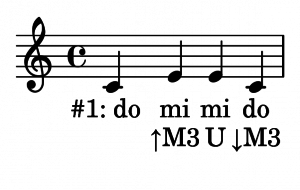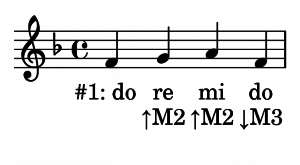
Melody Practice: Major Pentatonic
Practise identifying the notes of major pentatonic melodies by ear.
After completing this module: you will be able to reliably identify the notes of melodies based on the major pentatonic scale.
Module Preview
Contents
- Introduction
- Easy as do, re, mi
- So…
- Lah-dee-dah
- Top That!
Introduction
This module provides listening exercises to help you practice figuring out melodies by ear, when the melodies are based on the major pentatonic scale.
The major pentatonic is one of the most universally used scales in music. If you haven’t already, you can learn more about it in the Ear Expansion: Scales module and get used to its sound using the Scale Recognition module.
Note: This is a very flexible module – don’t be overwhelmed! At the bottom of this page you’ll find a suggestion for a simple way to get started.
The module is designed to help you whether you are using interval recognition, solfa, or both to figure out the notes in melodies. If you haven’t yet decided on an approach for sure (or you have developed skills with both) you should feel free to try both versions of the tracks and see which you have more success with.
It is important (and fun!) to connect your listening skills with your instrument playing whenever possible, so you will find tracks you can use to practice playing melodies by ear on your instrument too. If you read music you may want to connect your listening skills with traditional notation. You will find the scores provided, so that you can see the example melodies on a staff. Even if you don’t read music you may still want to take a look, as the score files also show the intervals and solfa so you can follow along that way too.
How it Works
This module has a sequence of lessons which gradually introduce all the notes in the major pentatonic scale. In each lesson you’ll find some information about the contents of the lesson, then some Training and Testing audio tracks and a set of Quizzes. The lessons offer three different difficulty levels to help you develop your skills:
- “Easy”: Short melodies which always start and end on the root (tonic) note of the scale.
- “Medium”: Slightly longer melodies which can start and end on any note.
- “Hard”: Longer, faster melodies.
All the audio clips are provided in three versions:
- Intervals: practice recognising the intervals between the notes.
- Solfa: practice identifying the solfa name of each note.
- Note Names: practice identifying the actual notes used, perfect for practising with your instrument.
You can listen to the audio tracks directly on these pages or download them to practice with on your computer or mobile device. Just right-click the track name beneath an audio player and choose “Save As” to download the MP3 file. You can view the score files directly in your web browser, or use the “Print” link to access a PDF file suitable for printing. Once you’ve used the Training and Testing tracks to develop your melody skills, use the Quizzes to test your new abilities and track your progress.
Step 1: Train
Use the “Training” tracks to listen carefully to examples of melodies with the answers provided, either as intervals between the notes, the solfa name for each note, or the note names. Each time you’ll hear the melody, then the labels, then the melody again, so that you can connect the “answer” with what you heard. In the Medium and Hard difficulties the melodies can start and end from any note, so you will hear the scale played before each melody to give you a sense of the key. The Note Names tracks also announce the key note before each melody, so you can get your bearings on your instrument, ready to try playing back what you heard. Try playing along with the scale when it’s demonstrated.
Intervals:
Solfa:
Note Names:

Step 2: Test
Once you think you’re getting the hang of recognising the notes of the melodies, listen to the corresponding “Testing” tracks. These are similar, but you will hear the melody, then a short pause for you to think about it, then the melody again slower. Then after a pause, the answer is given so you can check if you got it right, and finally the melody is played again. Try to work out the notes during the first two play-throughs, before the answer is announced. Then, whether you got it right or not, after the answer is announced play or sing along with the final repeat, thinking about the intervals or solfa being used. This will reinforce the right answer in your brain and ears.
Intervals:
Solfa:
Note Names:

Step 3: Quiz
If you’re getting the answers right while listening to the “Testing” tracks, it’s time to check your abilities by taking the corresponding quiz.
Summary
This is a very flexible module so don’t be overwhelmed by the number of tracks and options! Here is a simple way to get started:
- Choose your approach: intervals or solfa. You should already be clear on this by using other Musical U modules. If you’re really not sure, ask in your PJ or a new discussion.
- Start with the first lesson, and the “Easy” Training tracks corresponding to your approach (Intervals or Solfa).
- Listen to the tracks and try to figure out the melodies!
- Once you are getting the hang of it, try the “Easy” Testing tracks.
- Next, grab your instrument and try playing melodies by ear using the “Easy” Note Names tracks.
- When you’re ready, move on to the “Medium” tracks and repeat this process.
- You can either progress to the “Hard” tracks, or you might prefer to move on to the next lesson and introduce a new note to the scale. It’s up to you!
Ready?
Let’s start!

